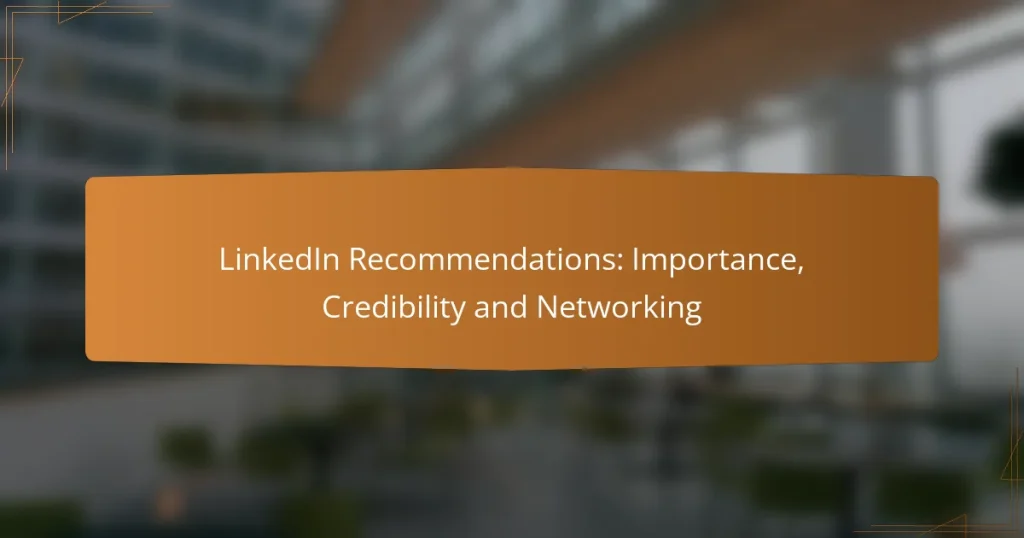Optimizing your LinkedIn profile is essential for attracting job opportunities and enhancing your professional image. By showcasing your skills, articulating your career goals, and engaging with relevant content, you can significantly increase your visibility to recruiters. Implementing best practices, such as customizing your URL and joining industry-specific groups, will further strengthen your networking potential and credibility on the platform.
LinkedIn Headline: Compelling, Targeted and Impactful
LinkedIn Recommendations: Importance, Credibility and Networking
How to optimize your LinkedIn profile for job opportunities
To optimize your LinkedIn profile for job opportunities, focus on presenting a professional image, showcasing your skills, and clearly articulating your career goals. A well-crafted profile increases your visibility to recruiters and enhances your chances of landing interviews.
Use a professional profile photo
Your profile photo is often the first impression potential employers will have of you. Choose a high-quality image where you are dressed professionally and smiling, as this conveys approachability and confidence. Avoid casual photos or images with distracting backgrounds.
Consider using a plain background to keep the focus on you. Ensure the photo is well-lit and clear, ideally taken by a professional or with a good camera. This small detail can significantly impact how your profile is perceived.
Craft a compelling headline
Your LinkedIn headline should succinctly convey your professional identity and aspirations. Instead of just listing your job title, include keywords that reflect your skills and the roles you are targeting. For example, “Digital Marketing Specialist | SEO & Content Strategy Expert” is more informative than simply “Marketing Specialist.”
Keep your headline under 220 characters to ensure it displays fully on all devices. This is a prime opportunity to attract attention, so make it count by highlighting what makes you unique in your field.
Write a detailed summary
The summary section allows you to tell your professional story in your own voice. Aim for 3-5 short paragraphs that outline your career journey, key achievements, and what you are looking for in your next role. Use this space to connect with your audience on a personal level.
Incorporate relevant keywords to improve searchability, but keep the tone conversational. This is your chance to showcase your personality and passion, making it easier for recruiters to see why you would be a great fit for their team.
Highlight relevant skills
List skills that are pertinent to your industry and the positions you are interested in. LinkedIn allows you to add up to 50 skills, but focus on the most relevant ones to avoid overwhelming viewers. Prioritize skills that match job descriptions you are targeting.
Consider grouping similar skills together to make your list more concise. Regularly update this section as you gain new skills or as industry demands change, ensuring your profile remains current and appealing to recruiters.
Request endorsements
Endorsements from colleagues and supervisors can enhance your credibility. Reach out to your connections and politely ask them to endorse your skills, particularly those that align with your career goals. A few genuine endorsements can significantly boost your profile’s attractiveness.
To increase the likelihood of receiving endorsements, offer to endorse others in return. This reciprocity can strengthen your professional relationships while enhancing your profile’s visibility and trustworthiness.
What are the best practices for LinkedIn profile optimization?
Best practices for LinkedIn profile optimization include customizing your URL, engaging with relevant industry content, and joining pertinent LinkedIn groups. These strategies enhance your visibility, credibility, and networking opportunities on the platform.
Customize your LinkedIn URL
Customizing your LinkedIn URL makes your profile easier to share and enhances your professional branding. Aim for a URL that includes your name or a relevant keyword, which can help in search results.
To change your URL, go to your profile, click on “Edit public profile & URL,” and select “Edit your custom URL.” Keep it simple and avoid using numbers or special characters that can complicate your link.
Engage with industry content
Engaging with industry content on LinkedIn helps establish your expertise and keeps you informed about trends. Regularly like, comment, and share posts that resonate with your professional interests.
Consider posting your own insights or articles to further showcase your knowledge. Aim for consistency; engaging with content a few times a week can significantly increase your visibility.
Join relevant LinkedIn groups
Joining relevant LinkedIn groups allows you to connect with like-minded professionals and expand your network. Look for groups that align with your industry or interests, as they often share valuable resources and discussions.
Participate actively by contributing to conversations and sharing your expertise. This not only builds your reputation but also opens doors to new opportunities and collaborations.
How to improve LinkedIn visibility in major US cities
Improving LinkedIn visibility in major US cities involves optimizing your profile and engaging with local networks. Focus on location-specific keywords and actively connect with professionals in your area to enhance your presence.
Utilize location settings
Setting your location on LinkedIn is crucial for appearing in searches relevant to your city. Ensure your profile lists your current city accurately, as this helps recruiters and potential connections find you more easily.
Consider adding nearby cities or regions in your headline or summary to broaden your visibility. For example, if you’re based in San Francisco, mentioning the Bay Area can attract more local opportunities.
Network with local professionals
Connecting with professionals in your city can significantly enhance your LinkedIn visibility. Attend local networking events or join city-specific LinkedIn groups to meet others in your industry.
Engage with local content by commenting on posts from nearby connections or sharing insights relevant to your area. This not only builds relationships but also increases your profile’s visibility within your local network.
What tools can assist with LinkedIn profile optimization?
Several tools can enhance your LinkedIn profile optimization by improving visibility and engagement. Utilizing these resources can help you tailor your profile to attract the right connections and job opportunities.
LinkedIn’s own optimization tool
LinkedIn offers an optimization tool that provides personalized suggestions based on your profile’s current status. This tool analyzes your profile and recommends enhancements, such as adding skills, endorsements, or a professional photo.
To access this feature, navigate to your profile and look for the “Profile Strength” section. Aim for a “All-Star” rating, which indicates that your profile is fully optimized for visibility.
Canva for profile graphics
Canva is a user-friendly design tool that allows you to create visually appealing graphics for your LinkedIn profile. You can design custom banners and images that reflect your personal brand and professional identity.
When using Canva, consider dimensions that fit LinkedIn’s requirements, such as a banner size of 1584 x 396 pixels. Incorporate your brand colors and fonts to maintain consistency across your online presence.
Jobscan for keyword analysis
Jobscan is a tool that helps you analyze your LinkedIn profile against job descriptions to identify relevant keywords. This can significantly improve your profile’s searchability by aligning it with industry-specific terms.
To use Jobscan, simply input your LinkedIn profile and a job description. The tool will highlight missing keywords and suggest additions to enhance your profile’s effectiveness in attracting recruiters.
What metrics should you track for LinkedIn profile success?
To measure LinkedIn profile success, focus on key metrics such as profile views, connection requests, and engagement on posts. Tracking these metrics helps you understand your visibility and the effectiveness of your networking efforts.
Profile views
Profile views indicate how many users have visited your LinkedIn profile. A higher number of views suggests that your profile is attracting interest, which can lead to more opportunities. Aim for a consistent increase in views over time to gauge the effectiveness of your profile optimization efforts.
To enhance your profile views, ensure your profile is complete and includes relevant keywords. Regularly updating your profile and engaging with your network can also boost visibility.
Connection requests
The number of connection requests you receive reflects your networking appeal. A steady influx of requests indicates that others find your profile compelling and relevant. Tracking this metric helps you assess the effectiveness of your outreach strategies.
To increase connection requests, personalize your connection messages and actively participate in industry-related groups. Avoid sending generic requests, as tailored messages are more likely to result in acceptance.
Engagement on posts
Engagement on posts measures how well your content resonates with your audience, including likes, comments, and shares. High engagement rates suggest that your posts are valuable and relevant, which can enhance your profile’s visibility.
To boost engagement, share insightful content that addresses your audience’s interests and challenges. Consistency is key; aim to post regularly and interact with comments to foster a community around your profile.
What are common mistakes in LinkedIn profiles?
Common mistakes in LinkedIn profiles include incomplete information, lack of engagement, and poor visual presentation. Addressing these issues can significantly enhance visibility and networking opportunities.
Neglecting profile completeness
Neglecting profile completeness is a frequent error that can hinder your professional image on LinkedIn. A complete profile typically includes a professional photo, a compelling headline, a detailed summary, work experience, education, and skills.
To ensure your profile is comprehensive, aim to fill out all sections. For instance, include at least five skills relevant to your industry, and write a summary that highlights your career achievements and aspirations. Profiles with complete information are often viewed more favorably by recruiters.
Regularly update your profile to reflect new skills or experiences. A good practice is to review your profile every few months, ensuring it remains current and relevant to your career goals. Avoid leaving sections blank, as this can signal a lack of professionalism or engagement.


